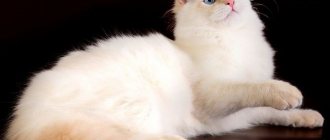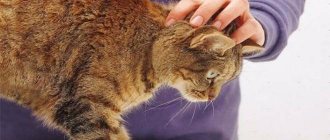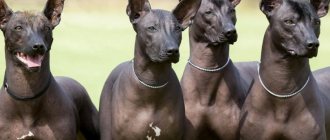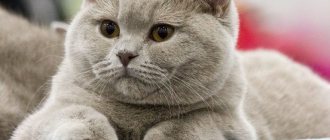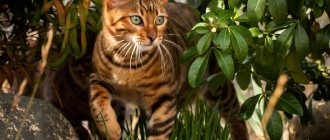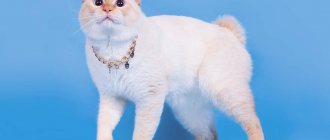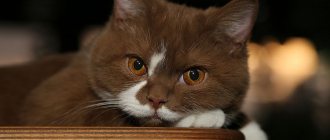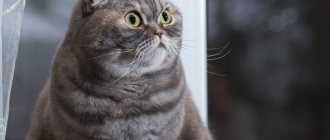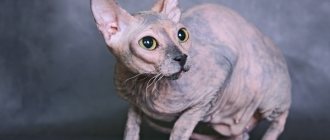Standard
To date, about 60 different shades of wool have been recorded. The British four-legged representative is:
- black;
- blue;
- lilac.
Among the most diverse types of the breed, cute chocolate-colored pets occupy a special place.
© shutterstock
In fact there are very few of them. This is due to the fact that this color is obtained by those cats who have Color Point ancestors with exactly the same shade. The British, whose coat has a similar color, are calm, friendly and cheerful. By the way, it does not cause big problems when cleaning indoors.
Black British breed standard
The head is a distinctive feature of all British people. She is large, round, with wide cheekbones and pronounced cheeks. The nose is always straight and short, and the forehead is flat and close to oval in shape. If you look at the chin, you can see that it seems to complement the whole picture with its massiveness and directness.
Particular attention should be paid to the ears. They are small in size and slightly rounded at the tips.
The ears are positioned in relation to each other at a ninety-degree angle. Particularly distinguished are the eyes of a cat - wide, large and open. The iris of the eye can change its shade in the first year and is established when the animal matures.
Many people define British people by their short and low body. Regardless of the gender of the animal, they are all massive and powerful. The same applies to strong and thick paws, as well as a dense, medium-length tail. The fur of felines is shiny and iridescent, with a thick undercoat. True Britons are so plush that sometimes it is impossible to reach their skin.
Wool
Chocolate is the key shade of the fur of British cats. It is distinguished by richness and depth . At the same time, the animal should not be spotted, that is, have light, especially white hairs. The shade is evenly distributed along the entire length of the fur, and the hairs themselves are very soft.
1-2 years should pass from the day the kitten is born and the moment it acquires a full chocolate shade. It happens that a British kitten’s fur becomes brown, but over time it “goes away.”
Fur of four-legged friends
The main color of animals is chocolate color. It has a deep and rich shade. According to the standard, there should be no tabby marks, spots or light-colored hairs at all. The chocolate pigment should be distributed evenly throughout the coat. In this case, the hairs should be soft and short.
Kittens take a long time to acquire a truly chocolate shade. In some cases, the formation process can continue for 15 months. Sometimes the fur can acquire a brown tint, as shown in the photo. However, over time, kittens lose it.
British cats can have fur of different shades of chocolate. Therefore, it will be possible to find pets whose fur coat may be the color of a bitter or milky dessert. A kitten of this color is very popular today. In this, it is not inferior to its purple and blue counterparts.
Representative appearance
Description of appearance will be short. The British chocolate cat has:
- massive build;
- wide cheekbones;
- short legs;
- round head;
- straight ears.
Purebred British kittens have copper, dark orange or dark brown eyes. The richer the better.
© shutterstock
Just a few decades ago, chocolate-colored cats could only be found among breeds of eastern origin. This means Burmese, Oriental and Siamese kittens. The British cat received its chocolate shade exclusively thanks to its Persian Color Point ancestors.
A kitten of this color is extremely popular, despite the fact that its cost is quite decent. All thanks to the beautiful and rich shade of soft fur.
Origin story
The breed appeared in Great Britain in the 19th century. About 10 years were spent on selection. The color was obtained by crossing recessive forms of British cats of chocolate and blue shades. According to statistics, only a quarter of pets are born with a similar shade. About 30 years ago, felinologists officially accepted the color.
The belief that the color was created by crossing a Scottish fold cat and a marbled cat is incorrect. The result of this will be the birth of kittens with disorders at the genetic level.
The British Lilac cat is not a separate breed, but belongs to British cats with short hair; the main difference with other representatives lies in the shade of the coat.
There is no breed of British Fold. There are only short/long-haired British and lop-eared/straight-haired Scots.
Character
Both small and adult four-legged representatives of the British breed are very affectionate, friendly, balanced and absolutely calm. Surprisingly, they easily endure separation from their owners, finding various activities for themselves. The main thing is that it does not drag on for long.
Chocolate-colored cats have practically no character, the exception being their diet. Here they are extremely picky. It often happens that the animal insists on serving food on time.
Therefore, the new owner will have to decide at the very beginning on the cat’s feeding regimen and strictly follow it.
© shutterstock
Description and color standard
In the mechanics of hair coloring for chocolate British cats, it is important to understand two components: pigmentation and genetics. A pair of pigments is responsible for the variety of colors in cats - eumelanin (black) and pheomelanin (red). At the moment of conception, the “chocolate” genetic instruction is transferred from the parents, along with the chromosome set, to the kitten
The location of the capsules with the dye and their density in each hair depends on it
A pair of pigments is responsible for the variety of colors in cats - eumelanin (black) and pheomelanin (red). At the moment of conception, the “chocolate” genetic instruction is transmitted from the parents, along with the chromosome set, to the kitten. The location of the capsules with the dye and their density in each hair depends on it.
Solid colors involve even coloring of the hair along its entire length - from the root bulb to its tip. Under the influence of the genetic code, a pigment of the desired color is produced in the cat’s body and enters the fur.
Other features depend on the combination of genes.
- Gene B is responsible for black color. In its dominant form, it gives a rich, deep charcoal shade.
- The next variety is bb. This is the chocolate color of cats.
- The final form of b1b1 is cinnamon, cinnamon, a clarified version of chocolate.
Genes that are responsible for the presence of patterns on the surface of the coat also take part in the formation of color. For example, the agouti gene (A) “allows” or “prohibits” the appearance of a pattern.
All striped and spotted patterns on the fur of a British cat appear only thanks to this component. To produce solid colors, a recessive aa (not agouti) is required.
Next comes the D gene (densepigmentation), which is responsible for color intensity:
- In the dominant form, D does not allow the fur to take on shades other than the specified color.
- The dd combination reduces the color intensity and lightens it by several tones.
The British chocolate-colored cat carries the genetic formula aabbD-, which determines all the parameters of the color of its coat - not agouti (aa), chocolate (bb), without bleaching (D). Exactly the same meanings are inherent in chocolate-colored Scottish Fold cats. The rules of genetics apply to everyone without exception.
British chocolate cats are also characterized by the following characteristics:
- copper, honey or amber eyes;
- brown nose;
- paw pads are brown or lightened cinnamon (cinnamon).
Upbringing
A person who wants to buy such a kitten after watching cute photos and videos needs to understand that from now on he will become the pet’s parent. Four-legged chocolate pets behave the same as representatives of other breeds. They are quite active, playful, affectionate, loving generous praise and care.
The British chocolate cat is inquisitive by nature. Because of the desire to know what is going on in the house, I am ready to sniff out and lick every centimeter of the apartment.
She is capable of charming anyone with just her appearance, even the most ardent opponent of pets, relying on her cute habits, habits and behavioral characteristics.
What color can blue-eyed cats be?
Most often you can find animals with light fur and bluish eyes. The most popular colors are white and Siamese.
The breed of blue cat with blue eyes is British. Moreover, this color is found in representatives of breeds with gray-bluish, white, cream coat colors. A distinctive feature of the British is the presence of a round muzzle, cheeks and a wide chest. If your eye color is blue, then it must be a pure heavenly shade.
Gray with a blue tint coat color with eyes of the same color is also possible in the Ragdoll breed.
The breed of black cats with blue eyes is a very rare occurrence. Animals of the Ojos Azules breed necessarily have heavenly colored eyes, and their coat color can be any color, including black.
Discipline
From an early age, one might say from birth, a kitten must be taught to behave correctly in order to avoid most troubles and protect it from bruises and injuries.
© shutterstock
The kitten must immediately understand what is good and what is bad. Beating as a punishment should be forgotten forever. You can prevent every prank only with a dissatisfied voice , so as not to anger him. With a competent approach to education, an already adult cat will not have the habit of showing his claws, biting painfully, trampling on things, or damaging armrests, backs of sofas and armchairs. And, of course, there must be sincere praise.
Solid colors of the British cat
There are only seven of them. Black, blue, chocolate, lilac, red, cream and white - they are divided by eye color. The color should be uniform, without spots, shades or white hairs. The presence of any drawing is also not allowed. The coat of the British is thick, short and soft to the touch (plush). And, perhaps, only their encodings are worth remembering. Everything else will be remembered by itself. So:
- Black (Black) BRI n
- Blue BRI a
- Chocolate BRI b
- Lilac BRI c
- Red BRI d
- Cream BRI e
- White BRI w
| Black (Black) BRI n | Blue BRI a |
| Chocolate BRI b | Lilac BRI c |
| Red BRI d | Cream BRI e |
The white color stands a little apart, since white British cats have the right to have orange or blue eyes and even different eye colors in the same animal! Eye color coding is done by number, namely:
- 61 – blue (blue) eyes,
- 62 – orange eyes,
- 63 – odd-eyed
| White with blue eyes BRI w61 | White with orange eyes BRI w62 |
| White, odd-eyed BRI w63 |
White British dogs are extraordinarily beautiful: their short, thick and soft coat is snow-white, without a hint of yellowness. Any shades and stains are excluded. It is no coincidence that the popularity of these animals has recently begun to increase. However, when breeding them, breeders face considerable difficulties.
At the felinological congress held in 1997, it was even decided to prohibit the breeding of white cats due to the high probability of the offspring developing such physical defects as lack of hearing, sense of smell, etc. In addition, it is not always possible to obtain offspring with with impeccable white fur and blue eyes.
Newborn white kittens may have subtle markings on their heads. If the animals were bred from blue Britons, the markings are pale blue; in the descendants of black cats, the markings are black. That's why it's often said that white Britons have their "ancestry written on their foreheads." Since in adult animals the marks disappear without a trace, their presence in kittens is quite acceptable.

